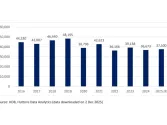
Singapore's life insurance workforce shrinks by 2.3% in 2024
Higher demand was noted in integrated shield plans and riders coverage.
Singapore’s life insurance manpower dipped by 2.3% year-on-year (YoY) in 2024, according to latest data by the Life Insurance Association of Singapore.
This brought the total workforce to 9,511 as of 31 December. During the same period, 12,767 representatives held exclusive contracts with tied-agency companies.
Additionally, the industry saw strong growth in Integrated Shield Plans (IPs) and Riders in 2024.
Total weighted new business premiums for Individual Health Insurance reached $462.35m (S$624.8m) for the year, marking a 103% increase in Q4 2024 compared to the same period in 2023.
IPs and IP riders accounted for $411.88m (S$556.6m), up 49.1% from the previous year, representing 89% of total Individual Health Insurance premiums.
Claims payouts also increased, with the industry disbursing $13.43b (S$18.12b) to policyholders and beneficiaries in 2024, a 33.4% rise from the previous year.
Of this, $11.97b (S$16.18b) was for policy maturities, whilst $1.44b (S$1.94b) covered death, total and permanent disability, and critical illness claims.
Par products made up 24% of total weighted new business premiums, non-par products 37%, and investment-linked products 39%.
Insurers with "Normal" licenses contributed 99% of total weighted new business premiums, whilst "Defined Market Segments" insurers accounted for the remaining 1%.
Looking ahead, LIA Singapore President Dennis Tan expressed optimism for 2025, citing increased consumer awareness, demand for sustainable insurance products, and digital transformation as key growth drivers.
However, he noted concerns over medical inflation, which is projected to rise by 12% in Singapore and in double digits across APAC.
Factors such as an aging population, rising costs of advanced medical treatments, potential overuse of healthcare services, and higher labour expenses contribute to this trend.
The industry is working with the government and healthcare stakeholders to maintain the accessibility and sustainability of quality healthcare.
($1.00 = S$1.34)



















 Advertise
Advertise






